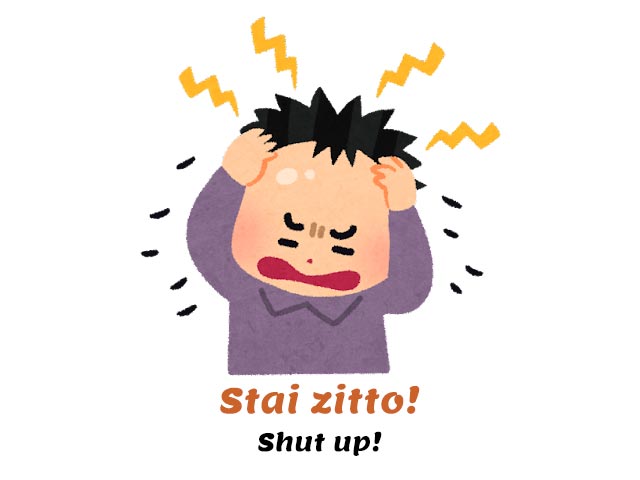How do you say it in Italian?
Stai zitto!
| Words you should know | Stare (to stay) + zitto (quiet) |
| When to use this | With 1 person you’re familiar with |
| When NOT to use this | With strangers (doh!) and groups |
Stai zitto!
Shut up! (masculine singular, informal, male)
Stai zitta!
Shut up! (feminine singular, informal, female)
For example, you can say…
Stai zitto, per favore.
Please shut up.
Sta’ zitto per cinque minuti!
Shut up for five minutes!

Stai can be shortened to sta’, with an apostrophe (never as stà, that’s a common mistake learners make and that a few natives make as well!). As said, it’s the second person imperative form of the verb stare, meaning to stay.
We then have zitto, which is an adjective translating silent.
Why two different versions? As said, zitto is an adjective, and adjectives in Italian must agree in gender and number with the noun.
If you are addressing a female, you’ll need to say stai zitta, following the same adjective rule we’ve seen in the previous paragraph.
Stai zitta, Anna!
Shut up, Anna!
(Anna is a feminine first name.)

State zitti!
| When to use this | With a group of people |
| When NOT to use this | With strangers (doh!) and 1 person at a time |
In Italian, unlike English, there are two kinds of “you”. There is a singular “you” and then there is a plural “you”. If you’re speaking to a group, you’ll need to conjugate any verb or pronoun accordingly, and don’t forget the gender!
State zitti!
Shut up! (masculine plural or mixed group, informal)
State zitte!
Shut up! (feminine group, informal)
You will use state zitti to address a group of men or a mixed group.
You will use state zitte to address a group of women (with no men).
For example, you can say…
State zitti, non riesco a concentrarmi.
Shut up, I can’t concentrate.
Stia zitto!
| When to use this | With 1 person you’re NOT familiar with |
| When NOT to use this | With friends, family and groups |
When speaking formally, Italians address each other with the subject “she”, lei. Use Lei in the written form if you want to be very polite.
Stia zitto!
Shut up! (masculine, polite)
There’s obviously a female variant:
Stia zitta!
Shut up! (feminine, polite)
For example, you can say…
Stia zitto, signor Rossi!
Shut up, Mr. Rossi!

This command features a third person singular conjugation. Basically, when speaking formally, Italians address each other with the subject “she”, lei. This is why we say stia (see the conjugation table in the previous paragraphs!).
I advise you against using stia zitto/a when you are among people you don’t know well, as it is very direct and quite rude.
Other ways to say shut up in Italian
Silenzio!
Instead of using one conjugation of the verb stare, you can simply translate shut up in Italian as silenzio!, following the behavior of quiet! in English.
Silenzio!
Quiet!
Silenzio, tutti quanti! Ho sentito un rumore provenire dal giardino.
Quiet, everyone! I heard a noise coming from the garden.
If you want to sound milder, you can add a per favore, please.
Silenzio, per favore!
Quiet, please!

Taci! Tacete! Taccia!
The last way to say shut up in Italian is taci, coming from the verb tacere meaning to shut up. This is quite aggressive.
As you probably already guessed, tacete and taccia are, respectively, the plural and polite forms of taci.
Taci!
Be quiet! Shut up! (singular, informal)
Tacete!
Be quiet! Shut up! (plural)
Taccia!
Be quiet! Shut up! (polite)
Taci, Giorgio, sto cercando di dormire!
Shut up, Giorgio, I’m trying to sleep!
Ragazzi, tacete un momento!
Guys, shut up for a moment!
More free Italian resources
You might want to keep learning Italian online with these free Italian resources:
❤️ If you liked this lesson on how to say shut up in Italian, share it with your friends!


